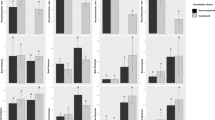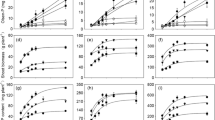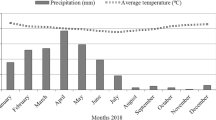Abstract
Multiple species of arbuscular mycorrhizal fungi (AMF) can colonize roots of an individual plant species but factors which determine the selection of a particular AMF species in a plant root are largely unknown. The present work analysed the effects of drought, flooding and optimal soil moisture (15–20 %) on AMF community composition and structure in Sorghum vulgare roots, using PCR-RFLP. Rhizophagus irregularis (isolate BEG 21), and rhizosphere soil (mixed inoculum) of Heteropogon contortus, a perennial C4 grass, collected from the semi-arid Delhi ridge, were used as AMF inocula. Soil moisture functioned as an abiotic filter and affected AMF community assembly inside plant roots by regulating AMF colonization and phylotype diversity. Roots of plants in flooded soils had lowest AMF diversity whilst root AMF diversity was highest under the soil moisture regime of 15–20 %. Although plant biomass was not affected, root P uptake was significantly influenced by soil moisture. Plants colonized with R. irregularis or mixed AMF inoculum showed higher root P uptake than non-mycorrhizal plants in drought and control treatments. No differences in root P levels were found in the flooded treatment between plants colonized with R. irregularis and non-mycorrhizal plants, whilst under the same treatment, root P uptake was lower in plants colonized with mixed AMF inoculum than in non-mycorrhizal plants.





Similar content being viewed by others
References
Allen SE (ed) (1989) Chemical analysis of ecological materials. Second Edition. Blackwell Scientific Publications, Oxford
Antunes PM, Lehmann A, Hart MM, Baumecker M, Rillig MC (2011) Long term effects of soil nutrient deficiency on arbuscular mycorrhizal communities. Funct Ecol 26:532–540
Augé RM (2001) Water relations, drought and vesicular-arbuscular mycorrhizal symbiosis. Mycorrhiza 11:3–42
Ausubel FM, Brent R, Kingston RE, Moore DD, Seidman JG, Smith JA, Struhl K (1999) Short protocols in molecular biology. Wiley, New York
Brodie E, Edwards S, Clipson N (2002) Bacterial community dynamics across a floristic gradient in a temperate upland grassland ecosystem. Microb Ecol 44:260–270
Brundrett M (1991) Mycorrhizas in natural ecosystems. In: Begon M, Fitter AH, Macfadyen A (eds) Advances in ecological research. Academic, San Diego, pp 171–313
Cavender-Bares J, Kozak KH, Fine PVA, Kembel SW (2009) The merging of community ecology and phylogenetic biology. Ecol Lett 12:693–715
Chen PS Jr, Toribara TY, Warner H (1956) Micro determination of phosphorous. Anal Chem 28:1756–1758
Chibber RK (1985) Soils of Delhi and their management. In: Biswas BC, Yadav DS, Maheshwari S (eds) Soils of India and their managament. The Fertilizer Association of India, New Delhi, pp. 72–86
Clark NM, Rillig MC, Nowak RS (2009) Arbuscular mycorrhizal fungal abundance in the Mojave desert: seasonal dynamics and impacts of elevated CO2. J Arid Environ 73:834–843
Curtis JT, McIntosh RP (1950) The interrelations of certain analytic and synthetic phytosociological characters. Ecology 31:434–455
Dijkstra F, Cheng W (2007) Moisture modulates rhizosphere effects on C decomposition in two different soil types. Soil Biol Biochem 39:2264–2274
Drigo B, Pijl AS, Duyts H, Kielal AM, Gamper HA, Houtekamer MJ, Boschker HTS, Bodlier PLE, Whiteley AS, Veen JAV, Kowalchuk GA (2010) Shifting carbon flow from roots into associated microbial communities in response to elevated atmospheric CO2. Proc Natl Acad Sci 107:10938–10942
Fitzsimons M, Miller R, Jastrow J (2008) Scale-dependent niche axes of arbuscular mycorrhizal fungi. Oecologia 158:117–127
Freitas RO, Buscardo E, Nagy L, Maciel ABS, Carrenho R, Luizão CC (2013) Arbuscular mycorrhizal fungal communities along a pedo-hydrological gradient in a Central Amazonian terra firme forest. Mycorrhiza 24:21–32
Götzenberger L, de Bello F, Brathen KA, Davison J, Dubuis A, Guisan A, Leps J, Lindborg R, Moora M, Partel M, Pellissier L, Pottier J, Vittoz P, Zobel K, Zobel M (2012) Ecological assembly rules in plant communities—approaches, patterns, and prospects. Biol Rev Camb Philos Soc 87:111–127
Grayston SJ, Griffith GS, Mawdsley JL, Campbell CD, Bardgett RD (2001) Accounting for variability in soil microbial communities of temperate upland grassland ecosystems. Soil Biol Biochem 33:533–551
Grman E (2012) Plant species differ in their ability to reduce allocation to non beneficial arbuscular mycorrhizal fungi. Ecology 93:711–718
Hart MM, Reader RJ (2002) Taxonomic basis for variation in the colonization strategy of arbuscular mycorrhizal fungi. New Phytol 153:335–344
Helgason T, Daniell TJ, Husband R, Fitter AH, Young JPW (1998) Ploughing up the wood-wide web? Nature 394:431
Helgason T, Merryweather JW, Denison J, Wilson P, Young JPW, Fitter AH (2002) Selectivity and functional diversity in arbuscular mycorrhizas of co-occurring fungi and plants from a temperate deciduous woodland. J Ecol 90:371–384
Herold N, Schöning I, Gutknecht J, Alt F, Boch S, Müller J, Oelmann Y, Socher SA, Wilcke W, Wubet T, Schrumpf M (2014) Soil property and management effects on grassland microbial communities across a latitudinal gradient in Germany. Appl Soil Ecol 73:41–50
HilleRisLambers J, Adler PB, Harpole WS, Levine JM, Mayfield MM (2012) Rethinking community assembly through the lens of coexistence theory. Annu Rev Ecol Evol Syst 43:227–248
Hoagland DR, Arnon DI (1950) The water-culture method for growing plants without soil. California Agricultural Experiment Station Circular 347:1–32
Holguin G, Vazquez P, Bashan Y (2001) The role of sediment microorganisms in the productivity, conservation, and rehabilitation of mangrove ecosystems: an overview. Biol Fertil Soils 33:265–278
Huber T, Faulkner G, Hugenholtz P (2004) Bellerophon: a program to detect chimeric sequences in multiple sequence alignments. Bioinformatics 20:2317–2319
Intergovernmental Panel on Climate Change (2001) IPCC Climate Change Synthesis Report, 397 Geneva, pp. 184
Jakobsen I, Rosendahl L (1990) Carbon flow into soil and external hyphae from roots of mycorrhizal cucumber plants. New Phytol 115:77–83
Jansa J, Smith FA, Smith SE (2008) Are there benefits of simultaneous root colonization by different arbuscular mycorrhizal fungi? New Phytol 177:779–789
Johnson NC, Wilson GWT, Bowker MA, Wislon JA, Miller RM (2010) Resource limitation is a driver of local adaptation in mycorrhizal symbioses. Proc Natl Acad Sci 107:2093–2098
Katoh K, Standley DM (2013) MAFFT multiple sequence alignment software version 7: improvements in performance and usability. Mol Biol Evol 30:772–780
Kiers ET, Lovelock CE, Krueger EL, Herre EA (2000) Differential effects of tropical arbuscular mycorrhizal fungal inocula on root colonization and tree seedling growth: implications for tropical forest diversity. Ecol Lett 3:106–113
Kiers ET, Duhamel M, Beesetty Y, Mensah JA, Franken O, Verbruggen E, Fellbaum CR, Kowalchuk GA, Hart M, Bago A, Palmer TM, West SA, Vandenkoornhuyse P, Jansa J, Bucking H (2011) Reciprocal rewards stabilize cooperation in the mycorrhizal symbiosis. Science 333:880–882
Kohout P, Sýkorova Z, Čtvrtlikova M, Rydlová J, Suda J, Vohník M, Sudová R (2012) Surprising spectra of root-associated fungi in submerged aquatic plants. FEMS Microbiol Ecol 80:216–235
Koide RT, Li M (1989) Appropriate controls for vesicular arbuscular mycorrhizal research. New Phytol 111:35–44
Lauber CL, Strickland MS, Bradford MA, Fierer N (2008) The influence of soil properties on the structure of bacterial and fungal communities across land-use types. Soil Biol Biochem 40:2407–2415
Lovelock CE, Andersen K, Morton JB (2003) Arbuscular mycorrhizal communities in tropical forests are affected by host tree species and environment. Oecologia 135:268–279
Maherali H, Klironomos JN (2007) Influence of phylogeny on fungal community assembly and ecosystem functioning. Science 316:1746–1748
McGonigle TP, Miller MH, Evans DG, Fairchild GL, Swan JA (1990) A new method which gives an objective measure of colonization of roots by vesicular-arbuscular mycorrhizal fungi. New Phytol 115:495–501
Miller SP, Sharitz RR (2000) Manipulation of flooding and arbuscular mycorrhiza formation influences growth and nutrition of two semiaquatic grass species. Funct Ecol 14:738–748
Nottingham AT, Turner BL, Winter K, van der Heijden MGA, Tanner EVJ (2010) Arbuscular mycorrhizal mycelial respiration in a moist tropical forest. New Phytol 186:957–967
Olsson PA, Johnson NC (2005) Tracking carbon from the atmosphere to the rhizosphere. Ecol Lett 8:1264–1270
Olsson PA, Rahm J, Aliasgharzad N (2010) Carbon dynamics in mycorrhizal symbiosis is linked to carbon costs and phosphorous benefits. FEMS Microbiol Ecol 72:123–131
Phillips JM, Hayman DS (1970) Improved procedure for clearing roots and staining parasitic and vesicular-arbuscular fungi for rapid assessment of infection. Trans Br Mycol Soc 55:158–161
Pringle A, Bever JD (2002) Divergent phenologies may facilitate the coexistence of arbuscular mycorrhizal fungi in a North Carolina grassland. Am J Bot 89:1439–1446
Rossi JP (2011) rich: an R package to analyse species richness. Diversity 3:112–120
Schüßler A, Schwarzott D, Walker C (2001) A new fungal phylum, the Glomeromycota: phylogeny and evolution. Mycol Res 105:1413–1421
Shannon CE (1948) A mathematical theory of communication. The Bell System Technical Journal 27: 379–423 and 623–656
Simon L, Lalonde M, Bruns TD (1992) Specific amplification of 18S fungal ribosomal genes from vesicular-arbuscular endomycorrhizal fungi colonizing roots. Appl Environ Microbiol 58:291–295
Sinsabaugh RL, Lauber CL, Weintraub MN, Ahmad B, Allison SD, Crenshaw C, Contosta AR, Cusack D, Frey S, Gallo ME, Gartner TB, Hobbie SE, Holland K, Keeler BL, Powers JS, Stursova M, Takacs-Vesbach C, Waldrop MP, Wallenstein MD, Zak DR, Zeglin LH (2008) Stoichiometry of soil enzyme activity at global scale. Ecol Lett 11:1252–1294
Smith SE, Jakobsen I, Gronlund M, Smith FA (2011) Roles of arbuscular mycorrhizas in plant phosphorus nutrition: interactions between pathways of phosphorus uptake in arbuscular mycorrhizal roots have important implications for understanding and manipulating plant phosphorus acquisition. Plant Physiol 156:1050–1057
Staddon PL, Thompson K, Jakobsen I, Grime JP, Askew AP, Fitter AH (2003) Mycorrhizal fungal abundance is affected by long-term climatic manipulations in the field. Global Change Biol 9:186–194
Stegen JC, Lin X, Konopka AE, Fredrickson JK (2012) Stochastic and deterministic assembly processes in subsurface microbial communities. ISME J 6:1653–1664
Tamura K, Peterson D, Peterson N, Stecher G, Nei M, Kumar S (2011) MEGA5: molecular evolutionary genetics analysis using maximum likelihood, evolutionary distance, and maximum parsimony methods. Mol Biol Evol 28:2731–2739
Torrecillas E, Alguacil MM, Roldan A (2012) Host preferences of arbuscular mycorrhizal fungi colonizing annual herbaceous plant species in semiarid Mediterranean prairies. Appl Environ Microbiol 78:6180–6186
van der Heijden MGA, Klironomos JN, Ursic M, Moutoglis P, Streitwolf-Engel R, Boller T, Wiemken A, Sanders IR (1998) Myocrrhizal fungal diversity determines plant biodiversity, ecosystem variability and productivity. Nature 396:69–72
van der Heijden MGA, Bardgett RD, van Straalen NM (2008) The unseen majority: soil microbes as drivers of plant diversity and productivity in terrestrial ecosystems. Ecol Lett 11:296–310
Verbrüggen E, van der Heijden MGA, Weedon JT, Kowalchuk GA, Röling WFM (2012) Community assembly, species richness and nestedness of arbuscular mycorrhizal fungi in agricultural soils. Mol Ecol 21:2341–2353
Verbrüggen E, Veresoglou SD, Anderson IC, Caruso T, Hammer EC, Kohler J, Rillig MC (2013) Arbuscular mycorrhizal fungi—short-term liability but long-term benefits for soil carbon storage? New Phytol 197:366–368
Wagg C, Jansa J, Schmid B, van der Heijden MGA (2011) Belowground biodiversity effects of plant symbionts support aboveground productivity. Ecol Lett 14:1001–1009
Wolfe BE, Weishampel PA, Klironomos JN (2006) Arbuscular mycorrhizal fungi and water table affect plant community composition. J Ecol 94:905–914
Acknowledgments
DK received a DU-DST PURSE grant from the University of Delhi, and SD received a Senior Research Fellowship from CSIR India. The authors thank Prof. P Pardha Saradhi for the greenhouse facilities, Prof. MGA van der Heijden for providing R. irregularis inoculum and two anonymous referees for their critical comments and suggestions that improved the manuscript.
Author information
Authors and Affiliations
Corresponding author
Electronic supplementary material
Below is the link to the electronic supplementary material.
Supplementary Fig. 1
Maximum likelihood tree showing the phylogenetic relationship among the arbuscular mycorrhizal fungal (AMF) sequences obtained in this study and their closest related sequences from the NCBI database (JPEG 1.60 mb)
Supplementary Fig. 2
Rarefaction curve of arbuscular mycorrhizal fungal (AMF) phylotype richness in Sorghum vulgare M35 roots analysed in this study. The clones are from three clone libraries each of a control, drought and flooded soil moisture regime (JPEG 22 kb)
Rights and permissions
About this article
Cite this article
Deepika, S., Kothamasi, D. Soil moisture—a regulator of arbuscular mycorrhizal fungal community assembly and symbiotic phosphorus uptake. Mycorrhiza 25, 67–75 (2015). https://doi.org/10.1007/s00572-014-0596-1
Received:
Accepted:
Published:
Issue Date:
DOI: https://doi.org/10.1007/s00572-014-0596-1




